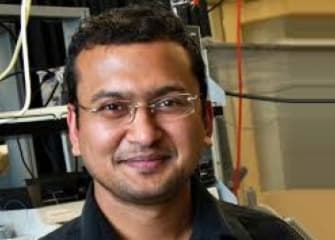
With the eyes of the nation upon them, leading ophthalmic researchers at the University of Colorado, Miami University and those from Nanoscope® , led by Samarendra Mohanty, PhD, were recognized as the winning top research team of the 3D-ROC challenge by the National Eye Institute (NEI).
The 3-D Retina Organoid Challenge (3-D ROC) is a prize competition to develop a physiologically-competent 3-D retina organoid?model, used to screen effectiveness of therapies as well as to transplant in the eyes of blind individuals. The tri-lateral team, which won $60,000, was selected for developing an organoid derived from stem cells and to the optical monitoring of cellular composition and functioning more clearly and efficiently.
“The challenge for Nanoscope was how to visualize and measure activities of cells from in-depth layers of the retinal organoid without perturbing their function,” Mohanty said. “Since the retinal organoid is light sensitive, we used near-infrared light to measure changes in reflectance from different layers using OCT (Optical Coherence Tomography) as well as the change in delay of the reflected infrared light reaching the detector when the specific targeted cell(s) of retinal organoid is (are) activated by visible light.”
Nanoscope developed an instrument, NS-QUANTA, which was used to achieve the above challenge. “NS-QUANTA is the first multi-modal OCT guided micro-focal Electro Retino Gram (mfERG) and Optical Retino Gram (ORG) product that is portable and provides the ability to simultaneously image and measure functioning of specimens such as the organoids,” said Madhu Rao, PhD, Nanoscope’s Instruments Marketing and Sales Lead. “Until recently, measuring function of cells inside a 3D tissue (e.g., organoid) for screening required invasive probing, thus destroying/contaminating the tissue preventing the use of the organoid for transplant.”
Using the NS-QUANTA instrument (www.nanoscopeinstruments.com), Nanoscope researcher Sanghoon Kim, PhD, first had to understand the layered-structure of the organoid, then deploy NS-QUANTA to measure the light-activated cellular activities in different layers. “One of the challenges was to obtain continuous light-activated activities from the organoid due to bleaching of photoreceptors. We had to strategize the stimulation and recording paradigm by optimizing the stimulation duration and intervals,” said Dr. Kim.
Researcher Subrata Batabyal, PhD, noted that this type of challenge “reflects what Nanoscope does well: develop de-novo solutions and instruments, which leverage the teams’ basic science and ophthalmologic research capabilities.” More information on the 3-D ROC winning team project is available here.
Using the NS-QUANTA instrument integrated with the microirradiation laser, a researcher can create models of retinal degeneration in the organoids (and animals) and deliver therapeutic (opto)genes to specific cells in a degenerated retina and monitor the structure as well as functioning of the regenerated/re-functionalized retina. The organoids provide unique opportunity for evaluating novel gene therapies including optogenetic therapies for vision restoration. This is an active therapeutic development area for Nanoscope.
Nanoscope Instruments (www.nanoscopeinstruments.com) has strong regional, national, and international collaborations in ocular and bio-medical research. In addition to probing the structure and functioning of tissues, Nanoscope® devices allow unique OCT-guided, non-viral delivery of genes and other molecules to targeted areas. These products are used by researchers for creating models of degenerative eye diseases, such as dry age-related macular degeneration (dry-AMD), which affects a significant portion of the global aging population, and for evaluating the efficacy of different cell-gene therapies by monitoring the structure and physiology of retina.
Nanoscope Instruments was incorporated in 2019 and is an affiliate of Nanoscope Technologies, LLC, which was founded in 2009 by Mohanty. Nanoscope has received several SBIR awards, National Institutes of Health (NIH) R01 grants, and patents that focus on optical stimulation, gene delivery and imaging for neural activity monitoring.









